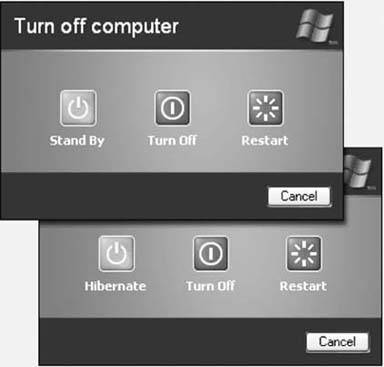2.5. Start  Shut Down ( Turn Off Computer) Shut Down ( Turn Off Computer) In Windows XP, this menu item is more powerful than its name implies. Choosing it opens a dialog box that offers several variations on "shut down" (see Figure 2-5): -
Stand By puts your computer to "sleep." This special state of PC consciousness reduces the amount of electricity the computer uses. It remains in suspended animation until you use the mouse or keyboard to begin working again. (This feature is available only if your computer offers it and you've turned it on in the Power Options program in the Control Panel.) Whatever programs or documents you were working on remain in memory.
Note: This information is stored only in memory, not on your hard drive. If your computer loses power, you lose all of the information that was stored in memory. To be absolutely safe, save your open documents before putting the PC in Stand By.
If you're using a laptop on battery power, Stand By mode is a real boon, because it consumes only the barest trickle of battery power. -
Shut down quits all open programs (or, in some cases, prompts you to do so), offers you the opportunity to save any unsaved documents, and then exits Windows. Most modern PCs then turn off automatically. If you're logged on to a workgroup network, this command may be called Turn Off.
Tip: You don't have to open the Start menu to turn off the computer. Just press the power button. (If that makes the PC sleep or hibernate instead, see Section 10.17.)
Figure 2-5. Here's the Shut Down dialog box on a workgroup PC. Press Shift to reveal the Hibernate button (bottom). If your company has a domain network, you choose these options with a drop-down menu instead of buttons . 
-
Restart quits all open programs, then quits and restarts Windows again automatically. The computer doesn't turn off. (You might do this to "refresh" your computer when you notice that it's responding sluggishly, for example.) -
Log off quits all programs, disconnects from the network, and then displays the Welcome screen so that the next person can log in. (The PC doesn't restart.) -
Hibernate shuts down the machine after it memorizes the state of your software, including all open operating system files, applications, and documents. Behind the scenes, it saves all this memorized information into a file on your hard disk. As a result, the Hibernate command doesn't work unless you have a lot of free disk space. The more RAM your computer has, the more disk space you'll need. (As with Stand By, this feature is available only if your computer offers it and you've turned it on in the Power Options Control Panel program.) The beauty of this feature is that when you start the computer again, everything returns to the way it was when you shut down fast . The same documents appear, the same programs are running, and so on. Hibernate, in other words, offers the speed and convenience of Stand By, with the safety of Turn Off. FREQUENTLY ASKED QUESTION
Turn Off Computer in the Start Menu | | Could someone explain why the Turn Off Computer command is in a menu called Start ? The Name-the-Button committee at Microsoft probably thought that you'd interpret Start to mean, "Start here to get something accomplished." But you wouldn't be the first person to find it illogical to click Start when you want to stop. Microsoft probably should have named the button "Menu," saving all of us a lot of confusion. |
|
 Shut Down ( Turn Off Computer)
Shut Down ( Turn Off Computer) 